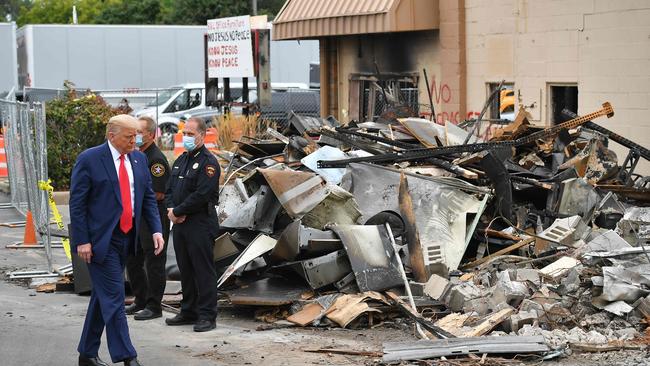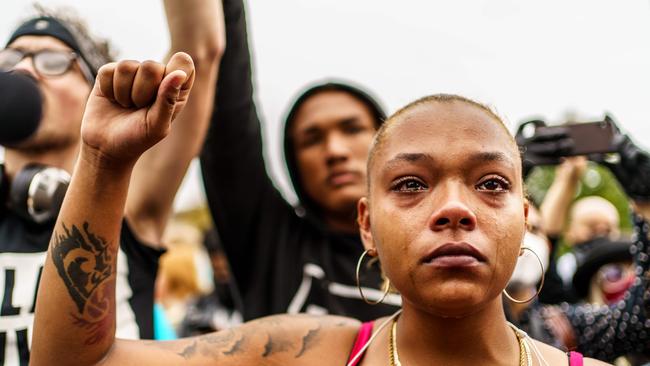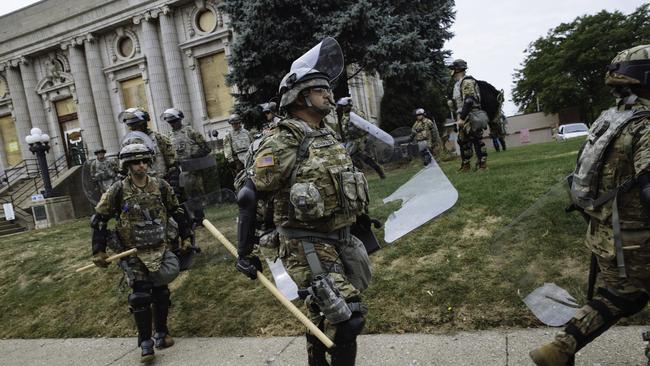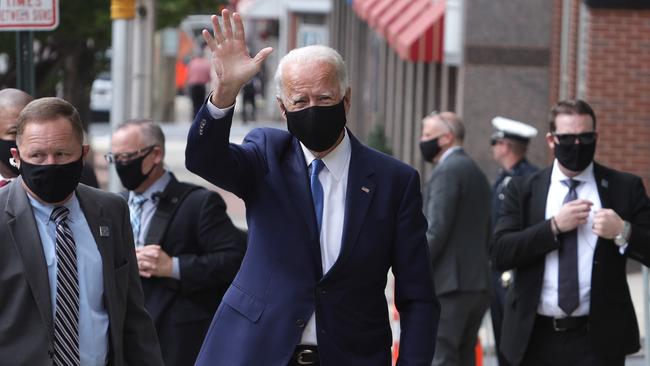Trump’s re-election campaign is rising from the ashes
If Donald Trump wins the election on November 3, historians will look to the last eight days as the time when the tide turned.

In this period Trump has tried to turn this election on its head, by unleashing a blunt yet potentially potent law-and-order campaign push that has his Democrat opponent, Joe Biden, struggling for answers.
Suddenly America is no longer talking about the deadly coronavirus pandemic or the crumbled economy it has left in its wake — the two issues that have delivered Biden a solid lead in the polls.
Instead, the nation is talking, if not shouting, over who is to blame for violence and civil unrest on the streets of US cities such as Kenosha, Portland, Minneapolis and elsewhere.
Nothing caught the moment more vividly than the sight of Trump’s presidential limousine driving through the riot-battered streets of Kenosha, Wisconsin this week as his supporters yelled out “thank you” and Black Lives Matter protesters gave him the finger.
“Kenosha has been ravaged by anti-police and anti-American riots … These are not acts of peaceful protests, but domestic terror,” Trump said.
“To stop the political violence we must also confront the radical ideology that includes this violence. Reckless far-left politicians continue to push the destructive message that our nation and our law enforcement are oppressive or racist.”
It’s a message targeted at the Democrats that Trump has pushed for months, but never so forcefully as during his acceptance speech at the White House late last week.
The political impact of the speech was amplified because it coincided with protests and riots that left businesses destroyed and two people dead in Kenosha, and more violent unrest this week in Portland, where another person was shot dead.
Now the Democrats and Biden are facing the twin challenge of a slight narrowing in the polls as Trump eats into Biden’s lead and signs that Americans are souring on the Black Lives Matter protest movement as it gets hijacked by a small number of violent thugs.
The Democrats have been outmanoeuvred on this issue by Trump, who has once again shown, as he did in 2016, that he has a natural gut instinct for understanding his support base and tapping into the fears of his “forgotten people”.
After being caught flat-footed, Biden and the Democrats are now scrambling to catch up after initially believing they could ignore the issue and keep the election focus on the pandemic and the economy.

Biden this week gave a major speech on the issue in Pittsburgh in which he condemned all forms of violence and accused Trump of fanning the flames of racial unrest for political gain.
“Rioting is not protesting. Looting is not protesting. Setting fires is not protesting. None of this is protesting. It’s lawlessness, plain and simple,” Biden said. “You know me. You know my heart, and you know my story, my family’s story. Ask yourself: Do I look to you like a radical socialist with a soft spot for rioters? Really?”
And yet Biden’s speech condemned by name “far right” groups, “white supremacists” and “vigilantes” but did not mention “far left” groups such as Antifa or the militant members of BLM who have perpetrated much of the violence.
This is Biden’s dilemma on the issue. He is supportive of race protests overall, the overwhelming bulk of which are peaceful, but he is wary of calling out by name those groups who then lead the violence. It makes Biden look as if he is pandering to the Bernie Sanders left wing of the Democrats, many of whom have been unhappy with Biden’s opposition to “defunding” the police and his claim that “I don’t think (policing) is rotten to the core”.
Although the polls have tightened slightly between Trump and Biden and the law-and-order debate has become front-page news, it is too early to know how potent this line of attack will be. Biden still holds a solid lead of between six and 10 points in polls taken after the Republican convention.
But Democrats in the crucial Midwest swing states are worried that Trump’s law and order push will play strongly to undecided voters. They want Biden to lift his game and campaign in person through America’s heartland.
Key Democrats, such as former Pennsylvania governor and Biden friend Ed Rendell, contacted Biden this week to send a message.
“What we were afraid of is moderates saying ‘I hate Donald Trump, but I need to be safe. I have to hold my nose and vote for him’,” said Rendell.
“The mood was nervous at the end of the Republican convention. The mood is better after (Biden’s speech in) Pittsburgh. But it can’t be one-off. He has to give that message over and over.”
Andy Levin, a Democrat congressman who represents a key district in suburban Detroit that voted for Barack Obama in 2012 before backing Trump in 2016 called on Biden to immediately start campaigning in person in Michigan.
“I don’t need Biden here on November 2 — I’m pushing for him to be here as early as possible, before all the absentee balloting gets going,” Levin told The Washington Post.
Trump’s attempt to portray US cities, 75 per cent of which are run by Democrats, as awash in violence is exaggerated for political purposes but there is enough truth to gain traction with some voters.
The nationwide mass protest movement, which began in late May with the police killing of George Floyd, has dwindled in most US cities to a small group of hardcore protesters, some of whom have often resorted to destroying property and small businesses or attacking police.
As a result, support for the previously popular BLM movement is ebbing as more Americans start to associate it with mob violence rather than a positive force for racial justice. If this continues it could become a liability for Democrats who have all but adopted the BLM movement as their own to highlight what they believe are the racist policies of the Trump administration.

A new Politico/Morning Consult Poll this week found that favourability for BLM fell from 61 per cent in June to 52 per cent. A separate poll, in the key swing state of Wisconsin, where Kenosha is located, also found support for the protest movement has fallen from 61 per cent after Floyd’s death to just 48 per cent in June.
“This is the direct effect of the strategy of Donald Trump and Fox News,” veteran Democratic pollster Cornell Belcher told Politico. “The movement to a certain extent, over the last month or so, had been losing ground in controlling the narrative.”
Both sides of politics fiercely debate the law-and-order issue, with Democrats saying protests have descended into violence in only a handful of US cities such as Portland, Kenosha, Minneapolis, Chicago and New York.
Democrats say the latest violence, which led to deaths in Kenosha and Portland, came because Trump encouraged his supporters and vigilantes to take to the streets to challenge the protesters.
Republicans say the law-and-order problems in Democrat-controlled cities goes beyond the issue of race-related protests and violence. They point out that homicide rates have spiked in big cities across the country amid the pandemic while gun sales and gun violence have also soared.
In Chicago there have been an astonishing 443 murders through July, a 53 per cent increase from last year, while New York has seen 280 murders, a 35 per cent increase. Across the country, the 25 largest cities have experienced a 16.1 per cent increase in murders. Meanwhile, fear for personal safety during the pandemic has caused gun sales to spike.

The Brookings Institution estimates three million more guns were purchased in the US between March and June compared to previous years, with half of them purchased during the protests after Floyd’s death.
“In March, concerns about personal safety arose from both a deadly new virus and an economy in free fall,” wrote researchers from a separate University of California study. “By June, concerns about the virus and the economy remained, and were compounded by new evidence of racial injustice in policing, widespread protests, and discussions of defunding the police.”
The burning question is how much the optics of growing lawlessness in the US will help Trump in this election campaign.
The same Politico/Morning Consult poll that showed a fall in support for BLM also shows more voters trust former vice-president Biden over Trump to handle public safety by 47 per cent to 39 per cent. Voters also prefer Biden on race relations by a 19-point margin.
Polls consistently show most Americans dislike Trump’s handling of the racial unrest since Floyd’s death. They also show voters believe the coronavirus and the economy are far more important than the issue of crime.
Republican pollster Chris Wilson says that at this early stage the polls show “that the protests are more an opportunity than an automatic win for Trump”.
“But this is the first issue in months that has the real possibility of shaking up the election and giving Trump the ability to make big gains,” he said.
The confluence of the Democratic convention, the Republican convention and the latest racial unrest in Kenosha and Portland make it difficult to disentangle exactly what is driving the polls right now.
This should become more clear in the weeks ahead as the dust settles and the trends emerge.
But the early indications are that Trump has emerged marginally stronger than Biden after the two party conventions.

Before the two conventions Biden enjoyed a 7.7-point lead over Trump according to the RealClear Politics average of polls. Biden’s RCP lead now sits at 7.2, a solid but not unbeatable lead with two months left in the campaign.
But Biden’s lead has shrunk in the key battleground states.
According to RCP, Biden leads by 2.6 points in Michigan, four in Wisconsin, 3.7 in Florida, five in Arizona, 3.4 in Pennsylvania and just 0.6 in North Carolina.
As a result, the Biden campaign has shaken up its strategy, which has previously relied almost exclusively on Biden conducting a virtual campaign from his home in Wilmington, Delaware.
The campaign now says Biden will do in-person campaigning through the battleground states and is formulating plans for him to travel widely throughout the country. This week, Biden stepped out for the first time, delivering his speech in Pittsburgh, Pennsylvania and on Friday he visited riot-hit Kenosha.
The Trump campaign also sees a glimmer of hope in the recent figures for the coronavirus pandemic, which has seen daily infections fall to around 42,000 compared with the peak of almost 70,000 in late July. While deaths have now passed 190,000 and still remain stubbornly high at almost 1000 a day, the campaign hopes the worst is over ahead of the November poll.
But the economy is still in a deep trough, with 10.2 per cent unemployment and businesses suffering across the board.
Trump’s law-and-order campaign has succeeded for the moment in its aim of distracting Americans from his mishandling of the pandemic and the associated economic pain.
Whether it works in the months ahead remains to be seen but it looks like Trump’s best chance of a game changer in this campaign.
Cameron Stewart is also US Contributor for Sky News Australia.




If Donald Trump wins the election on November 3, historians will look to the last eight days as the time when the tide turned.